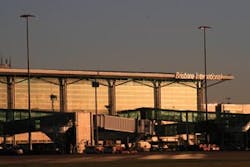Ground safety at an airport is an issue that many times requires cooperation of various stakeholders to understand the issue, set a standard and implement practices that result in a desirable outcome. At Brisbane Airport, through the participation of the airport, airlines and ground handlers, the Airside Operations Center Team executed several initiatives that have led to safer operations on the ground.
FOD Focus
The Airside Operations Team at Brisbane Airport — comprising of 20 officers, four supervisors and five management team members — set out to investigate origins of FOD, aiming to reduce FOD occurrences on the runway and taxiway systems.
As an airport with maintenance hangars located on the eastside directly across from terminals, the team found many items that appeared to originate from maintenance vehicles crossing the runway. “Some of the things we were finding were torches, screwdrivers, headsets,” says Aaron Pond, airside safety systems manager at Brisbane Airport. “They were falling off the back of engineering vehicles that were crossing throughout the night.”
Having found the origin, the team decided upon a solution: restricting all vehicles from crossing the runway other than tractors towing aircraft.
Of course, it was a standard that required the agreement of all parties involved, as the perimeter road route was about a 20-minute trip. Working in conjunction with the airport’s Airside Safety Committee, the operations team discussed the proposed solution. “We had to show them what we were finding, discuss the implications and get them to agree,” Pond says. “And when we went through that process, we found we got a 100-percent buy-in from everyone and was fully supported because they know the damage FOD can do to an aircraft. So that was a very important aspect of it — getting that buy-in. And we haven’t had any complaints.”
The team also stipulated that all vehicles at the airport must cover any loads in transit to reduce the risk of FOD, and adjusted the Airside Drivers Handbook to indicate the new restrictions.
The airport also instituted more frequent runway inspections, performing 8 inspections every 24 hours — a full serviceability inspection every six hours and a high-speed runway inspection every three hours. As well, the team conducts random inspections of tugs to ensure they do not carry items that could fall onto the taxiways or runways, according to Peter Dunlop, airside operations manager at Brisbane Airport.
Through such efforts, the airport has reported a reduction in the number of FOD by 99 percent.
Wildlife Management
Along with initiatives to reduce incidences of FOD, the team began investigating ways to reduce and manage wildlife around the airport. They looked into several different initiatives to accomplish the task.
“We promoted one of our officers to the position of wildlife control coordinator, and his focus is to look at our Wildlife Hazard Management Plan,” Dunlop says. “We have a monthly steering group committee, and we meet with the airlines every quarter. As a result of that, we have changed some of our strategies. We are doing a lot of passive management as well as active management, both onsite and offsite.”
Dunlop says the team targets high-risk wildlife that surrounds the airport in large numbers. “One of the birds frequent at the airport is “Ibis,” he says. “We manage their three known nesting sites off-site. That helps to minimise the number of birds at Brisbane Airport”
He continues, “But we find the most useful harassment on the airport is increased man hours, sirens, bird frite, horns and lights.”
Dunlop says the airport has continued to look into new strategies, including ways to more effectively managing its landscape to reduce wildlife numbers, all while communicating such strategies with stakeholders. “We actively report to the airlines with our initiatives and strategies,” he says.
Safety Discussions
Brisbane Airport began an Airside Safety Committee in 2005. The committee has grown over the years, beginning with approximately 15 members and now has more than 100 members, according to Dunlop. The Airside Safety Committee meets quarterly to discuss various safety issues. “We invite the airlines and ground handlers to present issues from any incidents that they have had and allow others to learn from those incidents,” he says. “We encourage airlines and ground handlers to present those various safety initiatives. It’s very much ownership by everybody.”
And in one of its most recent developments, an Airside Driving Subcommittee has been formed to foster safer operator practices on the ramp. “It’s a place where we felt we could improve the culture,” Dunlop says.
The subcommittee is chaired by Pond and includes representatives from each of the airlines, ground handlers and catering companies, consisting of a 16-member team. “It’s generally the trainers involved in this, so they can take the practices back to their organizations,” Dunlop says.
The subcommittee has been looking at different methods of testing drivers and issuing licenses, looking at the best practices to be included in the Airside Drivers Safety Handbook, according to Pond.
“We see this as a way of continual improvement and education in making sure and endeavoring to improve it further to have that ownership and transparency to our stakeholders,” Pond says. “Then the working group will report to the Airside Safety Committee what we’ve established and what we’ve improved on.”
Program Accolades
The program, which implemented many of the initiatives within a six-month period, received the attention of the Australasian Aviation Ground Safety Council, and was awarded the council’s 2010 Ground Safety Award.
“This was a significant achievement,” Dunlop says. “The Airside Operations Team have and continue to put in a tremendous effort towards the aviation and ground safety initiatives, and are very proactive in coming forward with new ideas. The award really showed that everyone can contribute towards safety. This was a true representation of strong collaboration between the airport operator, airlines, ground handlers, catering companies and everyone that works airside at Brisbane Airport. The award belongs to all of those who contribute to make airside safety their business at Brisbane Airport.”


